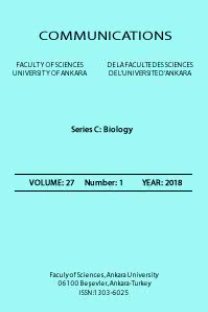A STUDY ON EPS PRODUCTION BY a MICROORGANISM EXPOSED TO COPPER(II) IONS
Öz The microorganism used in this study isolated from industrial wastewaters including heavy metals. The microorganism was tested with regard to its copper(II) removal and EPS production at different pH levels and copper(II) concentrations. The optimum pH was 7 for both copper(II) removal and EPS production of the microorganism. The highest copper(II) removal values were obtained as 45.3% at 21.0 mg/L copper(II) and 41.8% at 43.1 mg/L copper(II) concentrations after incubation for 7 days, respectively. On the other hand, the highest EPS production of the bacteria was 969.6 mg/L in media with nearly 50 mg/L copper(II) concentration. The increasing EPS production of the microorganism in media with copper(II) proved that copper(II) was attached to the EPS produced
Anahtar Kelimeler:
EPS, bacteria, copper(II), wastewater
___
Aksu, Z., 2005. Application of biosorption for the removal of organic pollutants: a review, Process Biochem, 40: 997-1026.Robinson, T., McMullan, G., Marchant, R., Nigam, P., 2001. Remediation of dyes in textile effluent: a critical review on current treatment technologies with a proposed alternative, Biores Technol, 77: 247-255.
Kurniawan, T.A., Chan, G.Y.S., Lo, W-H., Babel, S., 2006. Physico– chemical treatment techniques for wastewater laden with heavy metals, Chem Eng J, 118: 83-98.
Dönmez, G., Aksu Z., 1999. The effect of copper(II) ions on the growth and bioaccumulation properties of some yeasts, Process Biochem, 35(1- 2):135-142.
Bruins, M.R., Kapil, S., Oehme, F.W., 2000. Microbial resistance to metals in the environment, Ecotoxicol Environ Safety, 45:198-207.
Zhang, D., Wang, J., Pan, X., 2006. Cadmium sorption by EPSs produced by anaerobic sludge under sulfate-reducing conditions, J Hazard Mater, B138: 589–593.
Hugenholtz, J., Looijesteijin, E., Starrenburg, M., Dijkema, C., 2000. Analysis of sugar metabolism in an EPS producing Lactococcus lactis by 31P NMR. J Biotechnol, 77: 17–23.
Velasco, S., Arsköld, E., Paese, M., Grage, H., Irastorza, A., Radström, P., van Niel, E.W.J., 2006. Environmental factors influencing growth of and exopolysaccharide formation by Pedicoccus parvulus 2.6. Int J Food Microbiol, 111:252–258.
Ozdemir, G., Ozturk, T., Ceyhan, N., Isler, R., Cosar, T., 2003. Heavy metal biosorption by biomass of Ochrobactrum antropi producing exopolysaccharide in activated sludge, Biores Technol, 90: 71–74.
Cérantola, S., Bounery, J., Segonds, C., Marty, N., Montrozie, H., Exopolysaccharide production by mucoid and non-mucoid strains of Burkholderia cepacia, FEMS Microbiol Lett, 185 :243–246.
Dubois, M., Gilles, K.A., Hamilton, J.K., Rebers, P.A., Smith, F., Colorimetric method for determination of sugars and related substances, Anal Chem 28: 350–356.
Snell, F.D., Snell, C.T. (third ed.), (1959). Colorimetric Methods of Analysis 2, Van Nostrand, Canada.
Bhaskar, P.V., Bhosle, N.B., 2006. Bacterial extracellular polymeric substance (EPS): A carrier of heavy metals in the marine food-chain, Environ Int, 32:191-198.
Kazy, S.K., Sar, P., Singh, S.P., Sen, A.K., D’Souza, S.F., 2002. Extracellular polysacharides of a copper-sensitive and a copper-resistant Pseudomonas aeruginosa strain: synthesis, chemical nature and copper binding, World J. Microbiol Biotechnol, 18:583–588.
Kılıç, N.K., Dönmez, G., 2008. Environmental conditions affecting exopolysaccharide production by Pseudomonas aeruginosa, Micrococcus sp., and Ochrobactrum sp., J Hazard Mater, 154: (1-3):1019-1024.
- ISSN: 1303-6025
- Yayın Aralığı: Yılda 2 Sayı
- Başlangıç: 1943
- Yayıncı: Ankara Üniversitesi
Sayıdaki Diğer Makaleler
INVESTIGATION ON ANTIMICROBIAL EFFECTS OF SOME MOSS SPECIES COLLECTED FROM KASTAMONU REGION
Ergin Murat ALTUNER, Talip ÇETER, Esin BAYAR, Sinan AYDIN, Firdevs ARICI, Gizem SÜLEYMANOĞLU, Ayşenur EDİS
A STUDY ON EPS PRODUCTION BY a MICROORGANISM EXPOSED TO COPPER(II) IONS
TEMPERATURE AND THE LIFE CYCLE OF HETERODERA SCHACHTII (NEMATODA: HETERODERIDAE)
INVESTIGATION ON ANTIMICROBIAL EFFECTS OF SOME LICHEN SPECIES COLLECTED FROM KASTAMONU REGION
Ergin MURAT ALTUNER, Talip ÇETER, Duygu DEMİRKAPI, Kerime ÖZKAY, Uğur HAYAL, Gamze ESER
